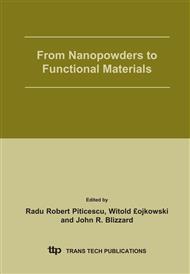p.109
p.117
p.123
p.127
p.133
p.141
p.145
p.149
p.153
Formation of Thallium Sulphide Layers on Polyethylene (PE) Sulphurised in a Solution of Higher Polythionic Acid
Abstract:
Thallium sulphide layers of different composition were obtained on the surface of polyethylene when it was sulphurised in a solution of higher polythionic acid, H2S33O6, and then treated with an alkaline solution of thallium(I) sulphate. The stoichiometric composition of the thallium sulphide layers varied between Tl0.3S and Tl2.6S depending on the formation conditions of the layers of TlxSy. A phase composition of the layers obtained was confirmed by X-ray photoelectron spectroscopy. The spectra of Tl 4f7/2, O 1s and S 2p showed the bond of thallium with sulphur in TlS and Tl2S , but Tl2SO4, Tl(OH)3, S8 and Tl2O3 were also found on the surface of the layers. Five thallium sulphide phases TlS, Tl2S, Tl2S2, Tl4S3 and Tl2S5 have also been identified in the layers by X-ray diffraction. The peaks of the TlS phase predominate in the diffractograms.
Info:
Periodical:
Pages:
133-140
Citation:
Online since:
September 2005
Authors:
Price:
Сopyright:
© 2005 Trans Tech Publications Ltd. All Rights Reserved
Share:
Citation:


